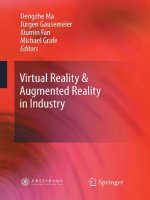THEORY INTO PRACTICE DOMAIN CENTRIC HANDHELD AUGMENTED REALITY GAME DESIGN FOR DESIGNERS
Bạn đang xem bản rút gọn của tài liệu. Xem và tải ngay bản đầy đủ của tài liệu tại đây (6.95 MB, 208 trang )
THEORY INTO PRACTICE: “DOMAIN-CENTRIC
HANDHELD AUGMENTED REALITY
GAME DESIGN” FOR DESIGNERS
KOH KOON CHUAN RAYMOND
NATIONAL UNIVERSITY OF SINGAPORE
2013
THEORY INTO PRACTICE: “DOMAIN-CENTRIC
HANDHELD AUGMENTED REALITY
GAME DESIGN” FOR DESIGNERS
KOH KOON CHUAN RAYMOND
(B.DES, AUCKLAND UNIVERSITY OF
TECHNOLOGY, NEW ZEALAND)
A THESIS SUBMITTED
FOR THE DEGREE OF
MASTER OF ARTS (INDUSTRIAL DESIGN)
DIVISION OF INDUSTRIAL DESIGN
NATIONAL UNIVERSITY OF SINGAPORE
2013
DECLARATION
I hereby declare that the thesis is my original work and it has been written by
me in its entirety. I have duly acknowledged all the sources of information
which have been used in the thesis.
This thesis has also not been submitted for any degree in any university
previously.
________________________
Koh Koon Chuan Raymond
31 December 2012
i
ii
Acknowledgements
The author would like to express his utmost appreciation to Dr. Henry
Been-Lirn Duh for his extensive research training, supervision, inspirations
and advice, as well as for the many opportunities and resources, including this
candidature. His strong support made this research possible. The author would
also like to thank Dr. Yen Ching Chiuan for the opportunity to take up this
candidature under his supervision in the Division of Industrial Design,
National University of Singapore (NUS). Finally, the author would like to
acknowledge the invaluable advice and support from his publication coauthors (full listing in Appendix H), external collaborators, colleagues and
friends, without whom many aspects of this interdisciplinary research would
not be complete. Particular mentions:
1. Research Design - HCI Domain (Study 1): Yu-Ning Chang, Institute of
Communication Studies, National Chiao Tung University, Taiwan
2. Research, Experimental Design and Data Analysis for User Study Education Domain (Study 2): Yun-Ting Wong, Keio-NUS CUTE Center,
NUS
3. Technical Development for “The Jackson Plan” game prototype
(Study 3): Cheng-Ho Chen, Keio-NUS CUTE Center, NUS
4. Host Research Institution: Mobile Interactive Media and Entertainment
Lab @ Keio-NUS CUTE Center, NUS (2011-2012)
iii
5. External Collaborators for “The Jackson Plan” game project (Study 3):
* Design School, Singapore Polytechnic
* Outram Secondary School, Singapore
6. Funding: This research is partially funded by project no. WBS R-705-000025-271, a grant from the National Research Foundation through the Ministry
of Education of Singapore, and project no. WBS R-705-000-029-592, an
industry research grant from Singapore Technologies Electronics (InfoSoftware Systems).
7. NUS Institutional Review Board - Approval Number: NUS 1623 / NUSIRB Reference Code: 12-224 / Date Approved: 5 July 2012 (Study 2).
iv
Summary
New media technologies have always unravelled design issues and
opportunities for designers, developers and users alike. The rapid
developments of both Augmented Reality (AR) and sophisticated mobile
technologies that revolve around smart and sensory features have raised
profound interests in the designs of handheld AR (HAR) games or game-like
user experiences. As extensions of fun games, these experiences can be used
to support various formal and informal activities (such as learning, training
and touring) in the real world on highly pervasive mobile devices, including
smart phones and tablets. Studies in this area however did not draw explicit
attention towards possibly exploiting the inherent characteristics of embedded
and ambient technologies to impact design and conceptualization processes of
such media. These include considerations for designing game activities, game
mechanics, user interactions, user experiences, and the co-creativity processes
of collaborations in design. One fundamental gap for designers to work with
HAR game media is manifested as missing design guidelines to fuse
knowledge domain (theory) with features of the evolving new AR technology
into tangible rule-based designs. This gap is attributed to the highly
interdisciplinary nature of AR and smart technologies that typically require an
initial understanding in disciplines of Computer Science, Engineering, Design,
Game Design, and Social Sciences. To address this gap, a multi-part research
has been conducted using “Education” as a case domain for HAR game design.
It consists of 3 studies that are centered on a conceptual framework that
dictates a triarchic and coherent interplay between system, application and
v
interaction elements to support the formulations of early design considerations
for HAR games (Study 1). Thereafter, a game design model is proposed for
structuring knowledge (educational) requisites that are grounded from a
selected operationalizing theory into the practical game design and
development
process.
Based on
the proposed model, the
design,
implementation and evaluation of a game prototype for situated history
learning as a case for translating theoretical considerations into game,
knowledge-based design styles and interaction designs are shared. The
evaluation with secondary school students validated transfers of the intended
communication goals (applied understanding of knowledge-based content) of
the contextual game media (Study 2). Real-world issues during prototype's
design and development in Study 2 are examined to elaborate on the proposed
game model’s practical usage. A co-creativity case is reported where two
students from a design school played dedicated artists’ roles for art and game
design developments respectively. Theoretical learning and curricular
elements were translated to meet the communication requirements of the
project through knowledge-based design strategies. The interdisciplinary
research and development collaboration also relates how a clearer
understanding of such didactic situations can empower and invoke coevolutions of both art and technology in HAR as a new media to design
gaming experiences (Study 3). The proposed game design methodology
consisting of the game framework and model is presented as the contribution
of this thesis. Application strategies and guidelines are summarized for
designers in the respective studies. To conclude, implications for the three
studies are discussed to highlight possible directions for future work.
vi
Table of Contents
Declaration.……………………………............................................................ i
Acknowledgements.......................................................................................... iii
Summary........................................................................................................... v
Table of Contents............................................................................................ vii
List of Tables.................................................................................................. xii
List of Figures................................................................................................ xiii
Chapter 1.
Introduction............................................................................ 1
1.1
Augmented Reality................................................................. 1
1.1.1
Knowledge-based Augmented Reality................................... 4
1.2
Games..................................................................................... 6
1.2.1
Handheld Augmented Reality for Games.............................. 7
1.2.2
Games and Real-World Activities.......................................... 8
1.3
Co-Creativity Processes in New Media Research.................. 9
1.3.1
The Practice............................................................................ 9
1.3.2
Maintaining an Equilibrium................................................. 10
1.3.3
Creative Apprenticeships..................................................... 11
1.4
Impact of Technology Dependency of Augmented Reality on
Design................................................................................... 13
1.5
Motivation and Scope of Research....................................... 14
1.6
Aims and Objectives............................................................ 14
1.7
Approach and Outline of Thesis........................................... 15
Chapter 2.
Literature Review................................................................. 19
2.1
Games................................................................................... 19
2.1.1
Game Design........................................................................ 19
2.1.2
Pervasive Games.................................................................. 20
vii
2.1.2.1 Established Genres................................................................ 20
2.1.2.2
Emerging Genres.................................................................. 21
2.1.3
Location-Based Games......................................................... 22
2.1.4
Serious Games...................................................................... 22
2.1.5
Gamification......................................................................... 22
2.2
Augmented Reality............................................................... 23
2.2.1
Handheld Augmented Reality.............................................. 26
2.2.2
Handheld Augmented Reality Games.................................. 28
2.2.3
Handheld Augmented Reality Game Design....................... 31
2.2.4
Knowledge-based Design..................................................... 31
2.2.5
Locations and Spaces as Loci of Contexts........................... 32
2.2.6
Seamful Design.................................................................... 34
2.2.7
Collaborative Augmented Reality........................................ 36
2.2.8
User Experiences of Handheld Augmented Reality............. 36
2.3
Education (Selected Knowledge Domain)........................... 37
2.3.1
Learning Objectives............................................................. 37
2.3.2
Situated Cognition................................................................ 38
2.3.3
Instructional Strategy........................................................... 39
2.3.4
Learning with Augmented Reality Technologies................. 40
2.3.5
Technology and Knowledge................................................. 40
2.4
Summary of Literature Review............................................ 41
Chapter 3.
Research Methodology......................................................... 43
3.1
Organization of this Research.............................................. 43
Chapter 4.
Study 1: A Triarchic Conceptual Framework for Handheld
Augmented Reality Games................................................... 47
viii
4.1
Overview of Study............................................................... 47
4.2
Procedures............................................................................ 47
4.2.1
Three Levels of Consideration............................................. 47
4.2.2
Literature Categorization Method........................................ 48
4.3
Results and Discussion......................................................... 49
4.3.1
The System Level................................................................. 49
4.3.1.1
Handheld Augmented Reality Systems................................ 49
4.3.1.2
Network Communication..................................................... 52
4.3.1.3
Handheld Devices................................................................ 54
4.3.2
The Application Level.......................................................... 56
4.3.2.1
Design with Contextual Information.................................... 56
4.3.2.2
Design for Learning............................................................. 57
4.3.2.3
Design for Social Interaction................................................ 58
4.3.3
The Interaction Level........................................................... 60
4.3.3.1
Manipulation........................................................................ 60
4.3.3.2
Movement-based and Metaphoric Interactions.................... 60
4.3.3.3
Feedback............................................................................... 63
4.4
Review of Study................................................................... 66
4.4.1
Framework Definition.......................................................... 67
4.4.2
Framework's Applicability in Design................................... 67
4.4.3
Framework Application Strategies....................................... 68
Chapter 5.
Study 2: A Domain-Centric Augmented Reality Game Design
Model................................................................................... 69
5.1
Overview of Study............................................................... 69
5.2
Procedures............................................................................ 70
5.2.1
A Game Design Model......................................................... 70
5.2.2
“The Jackson Plan” Game Design (Part 1).......................... 72
5.2.2.1
Context................................................................................. 72
5.2.2.2
Theoretical Design and Development (Study)..................... 73
ix
5.2.3
Prototype Evaluation (Quantitative)..................................... 80
5.2.3.1
Participants and School Selection........................................ 82
5.2.3.2
Experiment Setup................................................................. 82
5.2.3.3
Digital Book-based Group (Control Group)........................ 83
5.2.3.4
Instruments........................................................................... 83
5.2.3.5
Results.................................................................................. 85
5.3
Review of Study................................................................... 89
5.3.1
User Study............................................................................ 89
5.3.2
Design Issues for Designers................................................. 90
5.3.3
Guidelines for Designers...................................................... 91
5.3.4
Limitations and Directions for Future Work........................ 92
Chapter 6.
Study 3: Co-Creativity Fusions in Interdisciplinary Handheld
Augmented Reality Game Developments…....……............ 94
x
6.1
Overview of Study……….................................….............. 94
6.2
Procedures……………………………………………….... 95
6.2.1
The Initiative........................................................................ 95
6.2.2
Pre-Study.............................................................................. 96
6.2.2.1
Initial Design Themes.......................................................... 96
6.2.2.2
Design Considerations for Game Specifications.................. 97
6.2.2.3
Defining Real-World Game Space....................................... 98
6.2.3
“The Jackson Plan” Game Design (Part 2).…....……......... 99
6.2.3.1
Knowledge Empowerment and Access.............................. 100
6.2.3.2
Practice-based Co-Creation Group Activities.................... 101
6.2.3.3
The Co-Assignment............................................................ 103
6.2.3.4
Individual and Domain Sub-Group Contributions............. 103
6.2.3.5
Iterative Design.................................................................. 106
6.3
Design Outcomes……………………….….......………... 107
6.3.1
First Design Iteration (Concepts)....................................... 107
6.3.2
Second Design Iteration (Low Fidelity Prototype)............ 109
6.3.3
Third Design Iteration (Refined Prototype)....................... 112
6.4
Reflections..........………………………………….......…. 113
6.4.1
Relational Reciprocities..................................................... 113
6.4.2
Post-ITP In-depth Interviews with Student-Artists............ 114
6.4.2.1
Summary of Responses...................................................... 115
6.4.2.2
Interpretations of Responses (Qualitative)......................... 117
6.5
Review of Study................................................................. 118
Chapter 7.
Summary of Research…………………............................ 120
7.1
Limitations and Future Work….....…..………………...... 120
7.2
Implications and Conclusion……….….…....…...........…. 121
References...……………………………………..…………….................... 124
Appendices…………………...……………………….........……................ 139
Appendix A: Demographics Questionnaire (Study 2)......…...……........ 140
Appendix B: Instructional Materials (Study 2)………..........…….......... 143
Appendix C: Pre-Test Questionnaire (Study 2)……….........………...... 145
Appendix D: Post-Test Questionnaire (Study 2)…….......…........…....... 148
Appendix E: Learning Achievement Test (Study 2).......…..................... 153
Appendix F: Interaction flow diagram for “The Jackson Plan”
(Study 3)................................................................................................... 159
Appendix G: Newspaper Article……………..……………….....……... 160
Appendix H: Publications……………..……………….....…….…….... 161
xi
List of Tables
Table 1. Design levels for handheld augmented reality games....................... 46
Table 2. Applied design model in the domain of education with selective
references to respective concepts in discussion.............................................. 75
Table 3. Translating learning concepts into knowledge-based design styles.. 79
Table 4. Differences in evaluated experimental conditions............................ 83
Table 5. Translations of learning concepts to design elements (Individual and
Group)............................................................................................…….…… 96
Table 6. Guiding questions for in-depth interviews……………………...... 115
xii
List of Figures
Figure 1. Reality-Virtuality continuum............................................................. 1
Figure 2. The first AR/VR system.................................................................... 1
Figure 3. A 3D model on a fiducial augmented reality marker seen through a
head-mounted display....................................................................................... 2
Figure 4. Lighter, smaller and cheaper mobile augmented reality systems...... 2
Figure 5. Affordances of mobile augmented reality systems, (a): Traditional
“backpack system” and HMD, (b): Tablet PC, (c): PDA, (d): Mobile phones. 3
Figure 6. Overlaid graphics intended to display the action of tray pulling and
resultant tray state.............................................................................................. 5
Figure 7. Semantic loupe metaphor-based browsing operations with physical
mobile attachments and paper media................................................................ 6
Figure 8. A computer vision-based handheld augmented reality game where a
physical marker is required to be in view of the device's camera..................... 6
Figure 9. Overall structure of research............................................................ 16
Figure 10. Computer vision-based augmented reality using a fiducial
marker.............................................................................................................. 23
Figure 11. 2D marker types (from left): Template, ID and Datamatrix.......... 23
Figure 12. Photographic images registered for augmented reality natural
feature tracking (Top Right: Registered visual features are in yellow, Bottom:
3D planes can be attached to support virtual augmentations)......................... 24
Figure 13. Printed magazine pages and product packages being popularly used
as “markers” to trigger augmented reality experiences................................... 24
Figure 14. Top: Browser-based augmented reality combines location-sensing
(GPS) and geographical “points of interests” (POIs) to deliver the user
experience. Bottom: Users see a spatial representation of POIs through the
mobile phone’s camera view........................................................................... 25
Figure 15. Evolution of handheld augmented reality..................................... 26
Figure 16. Rich multi-modal features of a consumer smart phone................. 27
Figure 17. A multi-player handheld augmented reality game that utilizes game
props................................................................................................................ 30
xiii
Figure 18. Location accuracies of deployed sensing technologies................. 33
Figure 19. Triarchic conceptual design framework......................................... 47
Figure 20. Foot-based interaction on a handheld device................................. 50
Figure 21. Exploiting physical movements and computer vision-based
augmented reality game on a PDA.................................................................. 51
Figure 22. Overlaid virtual game elements, (a) Physical space is utilized. (b)
Physical objects/features are marked using a stylus pen. (c) Enemies' (A, B)
and Player's (C, D) attacks.............................................................................. 51
Figure 23. Three games with the same physical mechanics (from left to right):
“AR Puzzle Pacman”, “Terrain” and “Candy Wars”...................................... 52
Figure 24. Hiding in the “shadows”, Left: Outdoor player on the streets, Right:
Online view..................................................................................................... 53
Figure 25. “Expedition Schatzsuche” (a, b): Colour-coding of virtual content
indicate states of hotspots (green: free, yellow: in use, red: solved); (c):
solving a task by taking a photo of the specific item; (d): locality map
indicating all hotspots and their states............................................................ 56
Figure 26. Mobility and social interaction as core gameplay elements.......... 57
Figure 27. “6-Degree of Freedom” interaction for mesh editing in 3D space on
a 2D screen display......................................................................................... 61
Figure 28. Hand-tilted mobile maze game using in-built sensors................... 61
Figure 29. A remote handheld “Chinese Chess” game................................... 62
Figure 30. A metaphoric game mechanic (“pan on fire”) designed to induce
the player to keep the fiducial marker within the device's camera view......... 62
Figure 31. Face to face collaborative mobile augmented reality game........... 63
Figure 32. Red vertical bars as visual hints in a handheld augmented reality
game (right image) indicate that the marker tracking is not currently
working............................................................................................................ 64
Figure 33. Interplay of relationships in handheld augmented reality systems 65
Figure 34. Proposed game model for domain-centric handheld game design
(illustrated using “education” as the knowledge domain)............................... 71
Figure 35. Artifacts photographed at National Museum of Singapore, (Left):
Portrait of Sir Stamford Thomas Bingley Raffles. (Middle, Right): “Jackson
Plan” (1822)/Close-up..................................................................................... 72
xiv
Figure 36. The Singapore River today: Play-site for “The Jackson Plan”...... 73
Figure 37. Segmented progressive in-game map (3 pieces)............................ 76
Figure 38. Activity design for the educational location-based game trail....... 77
Figure 39. Designed interactions for mini-games (Circled) - Green: Player 1,
Blue: Player 2, White: Common game goals.................................................. 77
Figure 40. Students in evaluation trials........................................................... 80
Figure 41. Evaluation on learning................................................................... 84
Figure 42. Assuming wrong physical positions during mini-games (Facing the
screen, Player 1 with the physical card, is intended be on the left side next of
Player 2).......................................................................................................... 88
Figure 43. Model: mediatory effects on learning performance....................... 88
Figure 44. Direct isomorphic-mapping of game to real-world space.............. 98
Figure 45. (Left): Game structure for “The Jackson Plan”, (Right): Game area
/ map segmentation discussion...................................................................... 101
Figure 46. Conceptual overview................................................................... 104
Figure 47. Interaction flow diagram for “The Jackson Plan”........................ 105
Figure 48. Student A's artwork - Sketches and coloured backgrounds......... 107
Figure 49. Student B’s initial concept for Mini-Game 2............................... 109
Figure 50. Reflecting the Past in Present...................................................... 109
Figure 51. Low fidelity prototype (left to right): "Mini-Game 1", "Mini-Game
2", and "Panorama Artwork" feature............................................................. 110
Figure 52. Student B’s revised concepts: (Left): Mini-Game 1, (Right): MiniGame 2.......................................................................................................... 111
Figure 53. (Left) “The Jackson Plan”, (Right): 180º geo-registered panorama
artwork feature.............................................................................................. 112
Figure 54. Co-Creativity fusions................................................................... 119
xv
xvi
Chapter 1. Introduction
1.1 Augmented Reality
New media technologies have always unravelled design issues and
opportunities for designers, developers and users alike. Augmented Reality
(AR), as commonly defined, is the presentation of virtual content that is
registered in 3D in the physical real world that features interactions in realtime (Azuma, 1997). In an older Virtuality (VR) continuum proposed by
Milgram and Kishino (1994), AR is described only as a possible manifestation
of Mixed Reality (MR), which characteristically brings together real and
virtual elements within a single display (Figure 1). It is analogous to the
concept of ubiquitous computing by Weisser (1991) where large numbers of
computers and displays are described as embedded in the real world so that
they are an extricable and socially invisible part of our surroundings. By
utilizing projection displays and cameras, information may be projected on
and read from the environment (Wellner, 1991).
Figure 1. Reality-Virtuality continuum. (Source: Milgram, 1994)
Figure 2. The first AR/VR system. (Source: Sutherland, 1968)
1
Figure 3. A 3D model on a fiducial augmented reality marker seen
through a head-mounted display. (Source: Kato and Billinghurst, 1999)
Figure 4. Lighter, smaller and cheaper mobile augmented reality systems.
(Source: Mulloni and Wagner, 2010)
AR has come a long way since its first original conception by
Sutherland, (1968) in Figure 2 that utilized a Head-Mounted Display (HMD)
to track the user’s head position and orientation as in Kato and Billinghurst's
(1999) work in Figure 3. As a natural complement to mobile computing
research over the years (Wagner, 2007), AR has today for various purposes
found a place in handheld form as illustrated in Mulloni and Wagner's (2010)
work in Figure 4. This phenomenon can largely be attributed to the rapid
concurrent developments of both Augmented Reality (AR) and sophisticated
mobile technologies as platforms for synthetic information representations (as
shown in Wagner's (2007) illustration in Figure 5) (Chang, Koh, and Duh,
2011). The field of AR is interdisciplinary, spanning theories, research and
2
discussions from several affiliated disciplines other than computer science and
engineering that attempt to inform information presentations through design
from various perspectives; mobile design and information visualization in the
field of human computer interaction (HCI) for user interfaces and interactions
on screen-constrained devices; visual clutter; perception and attention focus
issues in cognitive sciences; multimodal and collaboration issues in
communications; form factors of AR in industrial design; game mechanics in
game design, etc.
Figure 5. Affordances of mobile augmented reality systems
(a): Traditional “backpack system” and HMD, (b): Tablet PC, (c): PDA,
(d): Mobile phones. (Source:Wagner, 2007)
Mobile technologies that exploit “smart” and sensing features enable
the presentations of user, device or ambient related information (i.e. users’
physical locations, user-generated multimedia content, user and environmental
contexts, connectable digital network protocols such as WiFi and Bluetooth,
orientations of devices being used, embedded sensor data, and larger datasets
such as weather and road traffic data, etc.) that contain optional social
elements (i.e. sharing and collaborating via social media platforms such as
3
FourSquare 1 or Facebook 2 ). AR technologies are today popularly used to
provide field and in-situ context-aware services because of information
visualization, user interaction, technological infrastructure connectivity and
(location and device) sensor data fusion capabilities. Applications include
personalized advertising or marketing, information on local events, remote
collaborations, guidance through unfamiliar locations, and for entertainment,
all of which interactions between people, technology and the environment
enable learning (FitzGerald, 2012). User interactions with interfaces for AR
have however fundamentally changed over the years with the advancements in
AR and mobile technologies that have led to differences in form factors
(Figure 4) and new affordances of mobile AR systems (Figure 5).
1.1.1
Knowledge-based Augmented Reality
A well designed presentation makes it possible for users to experience
a nonexistent world or one that exists in another time or place, but designing
AR information presentations requires significant skill and time because
increasing the richness and variety of the information that a system is able to
present also increases the difficulty of presenting it well (Feiner, MacIntyre,
and Sellgman, 1993). It requires coordinated design of material that invokes
featured sensory modalities that must continuously respond to user
interactions, both implicitly and explicitly (MacIntyre, Bolter, Moreno, and
Hannigan, 2001), i.e. providing vibrations whenever the device is pointed at
the “right” direction towards the next navigation waypoint in outdoor
environments. In knowledge-based AR systems, virtual worlds are created to
1
2
4
overlay and complement the user’s view of the real world that dynamically
takes into account information on the user, task and changes in the real world.
Following this track, Feiner et al. (1993) proposed the use of “designed
illustrations” as a (graphical) design component to support the intended
communicative goals of information that is supplemented to users in an AR
system and is meant for aiding task-solving in real-world 3D space (Figure 6).
This will be described in fuller detail in the next chapter (Section 2.2.4). In
building game and AR interfaces for use in physical environments, there is
also a growing design space for prototyping physical props and attachments
for devices in order to communicate and aid user interactions and enrich
experiences, i.e. Sueda, Gu, Kitazawa, and Duh 's (2011) work in Figure 7.
Figure 6. Overlaid graphics intended to display the action of
tray pulling and resultant tray state.
(Source: Feiner, MacIntyre, and Sellgman, 1993.)
5









